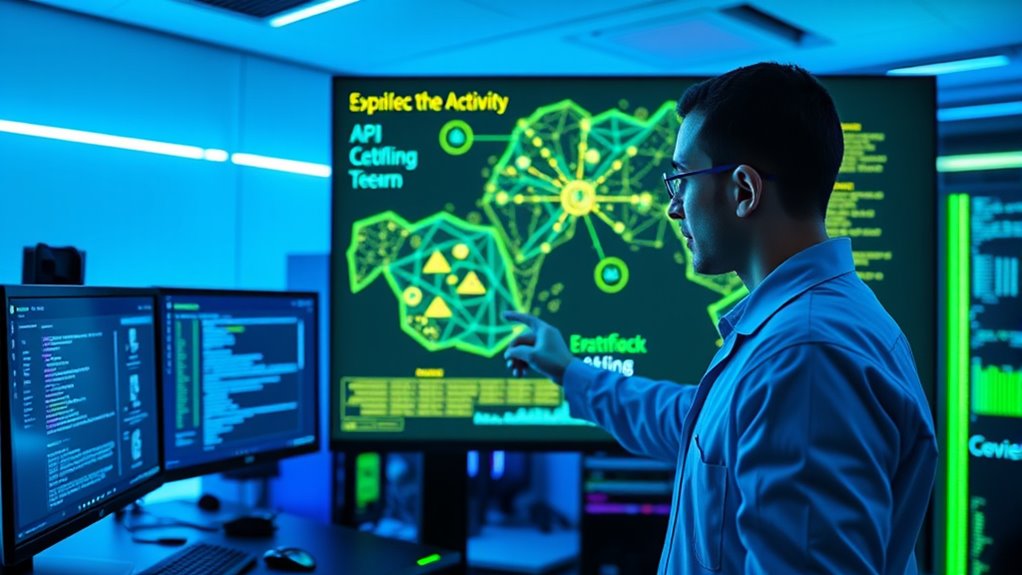AI helps you detect cryptojacking threats by analyzing system behaviors and spotting subtle malicious activities. It uses machine learning models to identify anomalies like unusual CPU usage, suspicious processes, and abnormal system calls in real time. Adaptive techniques allow AI to evolve with new attack methods, offering continuous protection. By combining multiple detection strategies, AI provides an extensive security approach. Keep exploring how these systems work to stay one step ahead of threats.
Key Takeaways
- AI analyzes system behavior to identify hidden cryptojacking activities through pattern recognition and anomaly detection.
- Machine learning models are trained on large datasets to detect subtle mining signatures and irregular processes.
- Adaptive AI systems continuously update with threat intelligence, improving detection of evolving cryptojacking techniques.
- Hybrid detection approaches combine signature, behavioral, and machine learning methods for comprehensive protection.
- AI enables real-time monitoring and response, reducing system compromise duration and enhancing cybersecurity defenses.

Artificial Intelligence (AI) has become a pivotal tool in the fight against cryptojacking, a malicious activity where cybercriminals secretly use your system’s resources to mine cryptocurrencies. You might not notice it at first, but AI helps detect these hidden threats by analyzing patterns and spotting anomalies in how your system behaves. Machine learning models are trained on large datasets to recognize both known and emerging mining activities. When these models analyze your system, they look for irregular CPU usage, unusual process relationships, and suspicious system calls that could indicate cryptojacking. This real-time analysis allows security tools to identify threats as they happen, preventing damage before it spreads. Continuous learning enables AI systems to adapt to evolving cryptojacking techniques and improve detection accuracy over time. Additionally, threat intelligence feeds help AI systems stay updated on new attack methods by integrating the latest security insights. Incorporating behavioral detection further enhances the ability to identify stealthy threats that bypass signature-based methods. AI doesn’t work alone; it’s integrated into extensive security platforms to offer a layered defense. These platforms combine various detection methods to maximize accuracy. Signature-based detection, for example, compares active scripts against a database of known cryptojacking signatures to catch familiar threats. Behavioral detection, for instance, examines your system’s behavior to spot activities that don’t fit normal patterns, catching more stealthy or new threats. Machine learning-based detection leverages advanced models that recognize subtle, complex patterns indicative of mining, even when threats try to hide. Some security solutions combine these approaches into hybrid systems, which improve detection rates by covering the weaknesses of individual methods. Blockchain-based detection is another emerging technique that uses the technology’s transparency to identify and prevent illicit mining activities. Understanding the sound design principles behind data analysis can help in developing more effective detection systems.
The core of AI’s effectiveness lies in machine learning. These models are trained on diverse datasets to recognize cryptojacking signatures and behaviors, enabling them to detect anomalies in your system’s processes and activities. They monitor containers and processes continuously, providing high-precision detection with minimal false positives. Their ability to analyze data in real-time means threats are identified and addressed immediately, reducing the risk of prolonged compromise. Data privacy challenges also influence how these detection systems are designed, emphasizing the importance of secure data handling practices.
Frequently Asked Questions
How Does AI Differentiate Between Legitimate and Malicious Mining Activities?
You might wonder how AI tells genuine mining from malicious ones. It analyzes behavioral patterns like CPU usage, process activities, and network traffic. AI uses machine learning to spot anomalies and recognize known malicious signatures. When it detects suspicious resource spikes or unusual connections, it automatically flags or stops the activity. This continuous monitoring and real-time analysis help you differentiate legitimate mining operations from malicious cryptojacking, keeping your system secure.
What Are the Limitations of AI in Real-Time Cryptojacking Detection?
Imagine a vigilant guard watching a busy marketplace, trying to spot subtle signs of theft. Similarly, AI faces hurdles in real-time cryptojacking detection. You encounter high false alarms, as legitimate activity mimics threats. The evolving tactics of cybercriminals challenge your system’s agility. Limited processing speed and resource constraints slow your response, making it difficult to catch stealthy attacks promptly, risking undetected threats slipping through your watchful eye.
How Can Organizations Integrate AI Tools Into Existing Cybersecurity Frameworks?
To integrate AI tools into your cybersecurity framework, start by evaluating your current security setup to identify gaps. Choose AI solutions with proven effectiveness and ensure they’re compatible with your existing systems. Incorporate AI as an additional layer for behavior monitoring, anomaly detection, and automated responses. Regularly update and tune these tools, and train your team to interpret AI alerts, making your defenses more resilient against emerging threats.
Are There Privacy Concerns Related to AI Monitoring Network Traffic?
Imagine your network traffic as a busy highway, with AI acting as a vigilant traffic cop. While it helps spot threats, it also raises privacy concerns—like unauthorized data access or covert collection. You might worry about transparency and consent, especially if data is misused. To address this, you need strict regulations, clear user controls, and transparent AI practices that protect user privacy without compromising security.
What Future Advancements Are Expected in Ai-Driven Cryptojacking Detection?
You’re wondering about future advancements in AI-driven cryptojacking detection. Expect AI to improve real-time detection and automate responses, making it easier to identify threats quickly. You’ll see better integration with SIEM and XDR systems, along with predictive analytics for proactive prevention. Enhanced models will handle large datasets efficiently, and hybrid approaches will boost accuracy. As threats evolve, AI will need continuous updates to stay ahead of sophisticated cryptojacking techniques.
Conclusion
Think of AI as your vigilant lighthouse, constantly scanning the dark seas for lurking pirates—cryptojacking threats. As cybercriminals try to hide their ships in the shadows, AI shines its light, guiding you safely away from danger. With its sharp eyes and quick responses, you stay one step ahead, steering through treacherous waters. Embrace AI’s power, and let it be the steadfast guardian that keeps your digital voyage secure and unspoiled.











